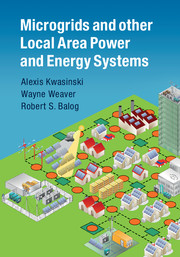4 - Power converters
from Part II - Technologies
Published online by Cambridge University Press: 05 July 2016
Summary
Introduction
Power electronics is the enabling technology for efficient and controllable conversion of electrical energy. Prior to the invention of the transistor in 1947 at Bell Labs – and more importantly the first power semiconductor, the silicon-controlled rectifier invented by GE in 1957 [1] – electrical energy at high power levels was not controllable except through crude and inefficient methods. This chapter will present the fundamental topo-logies, analysis, and control-of-power electronic technologies used as the basic building blocks of local area power and energy systems. The basic concepts of ac-dc, dc-dc, and dc-ac converters will be discussed with application to multiple converter systems. Primary topics will include topologies, control, and practical implementation.
Treatment of ac to dc rectifiers will cover point of load aspects such as power quality and controllability in ac architectures, including single and multiphase systems. Conversion of dc to dc power will play a central role in small-scale power systems because most renewable energy (photovoltaics) and energy storage (batteries) are dc voltage. Then dc to dc conversion will be presented as a key enabling technology, including single and multi-input topologies, and bidirectional power flow. The final section of this chapter will be devoted to dc to ac converters (also known as inverters). This section will cover the three main circuit topologies for inverters (voltage, current, and impedance source). Then, discussion of modulating and control techniques will show how these topologies link to single and multiphase ac small-scale power systems. It must be noted that this chapter represents a basic overview of power electronics as a subject of study and not as a comprehensive guide. The reader is encouraged to consult a power electronics text such as [2]–[4] for more in-depth treatment of these subjects and a more comprehensive listing and treatment of converter topologies.
Power conversion concepts
In general, a power electronic interface enables a controllable bidirectional energy flow between electrical sources and loads, as illustrated in Figure 4.1. In LAPES, the distinction between “sources” and “loads” can sometimes be undefined and may depend on time and system conditions. This conversion can involve changes in voltage levels and galvanic isolation depending on the needs of the application.
- Type
- Chapter
- Information
- Microgrids and other Local Area Power and Energy Systems , pp. 123 - 164Publisher: Cambridge University PressPrint publication year: 2016



